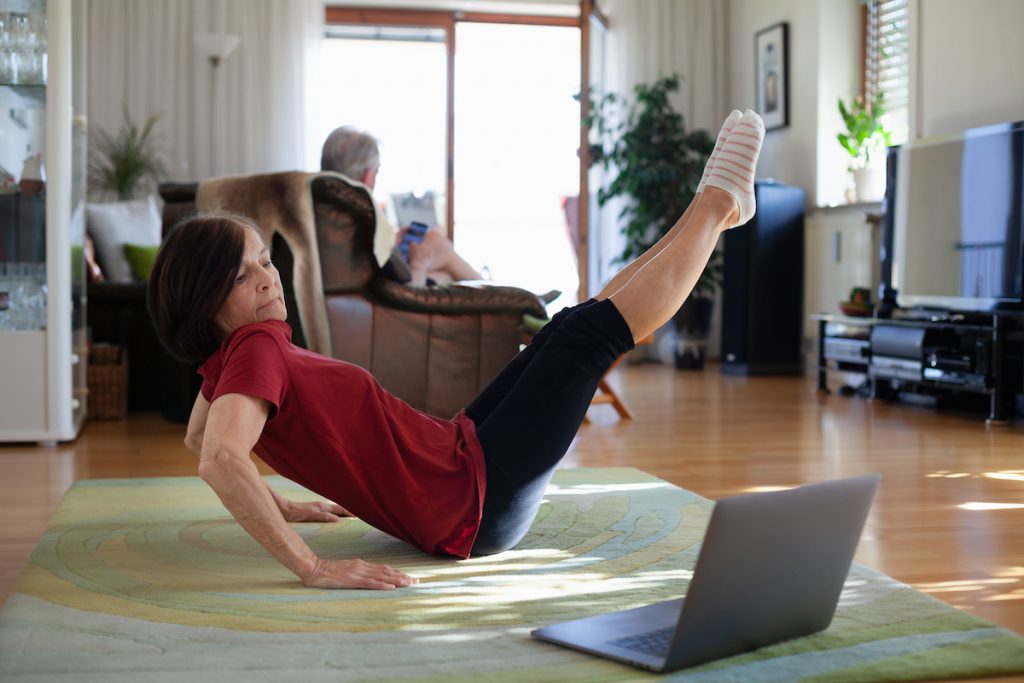Lose the Weight, Keep (Even Gain!) the Muscle: Your 3-Step Plan
Here’s what you need to know to keep your weight in line and boost muscle mass as you age.

True or false: The “middle-aged spread” is a given?
Odds are you answered, True. After all, research shows that muscle mass starts to decline after age 30 and speeds up once you hit 60. And it’s only a hop, skip, and a jump to the studies that show that lost muscle mass gets replaced by fat — hence the “spread.”
But here’s why False is the better answer: The one-two punch of weight creep and muscle decline in your golden years is only a given if you give in to that outdated notion. There are simple steps that can help you steady your weight and your strength as you age.
“It’s shocking to me how many people believe gaining weight and losing strength is just a ‘normal’ part of aging when it doesn’t have to be the case,” says Stephen Perrine, co-author of The Whole Body Reset: Your Weight-Loss Plan for a Flat Belly, Optimum Health & a Body You’ll Love at Midlife and Beyond. “The prevailing belief is that there’s a point at which it’s too late to gain muscle mass back, but that’s simply not true.”
More than vanity is on the line, too: Reduced muscle, a condition known as sarcopenia, can set you up for a range of health problems, including weakness, chronic disease, insulin resistance, inflammation, and frailty. Pushing back against that muscle loss is a major part of staying healthy, but it turns out that many older adults might not be pushing in the right way, says Perrine.
To get started on reversing the muscle mass loss — and losing fat along the way — there are three major strategies that can be transformational. Here’s your new plan:
Step #1: Focus on Protein Timing
This is the biggest change you can make, believes Perrine, and it can have a ripple effect on your energy as well as your waistline. The way most Americans stack their protein throughout the day is problematic, he says.
“The average American eats the right amount of protein daily — about 75 to 90 grams — but in the wrong way,” he notes. “They’ll have maybe 10 grams at breakfast, 20 at lunch, and 60 at dinner. The body can only use about 30 to 40 grams at a time, so what happens to the rest of it? That turns to fat.”
A much better approach is to space protein more evenly throughout three meals. A high-protein breakfast is particularly important to boost your energy for the day, he says. And don’t forget your snacks. Edamame, roasted chickpeas, even a hard-boiled egg are all protein-packed ways to tide you over between meals. Don’t forget to pair your protein with vegetables and fruit for a well-balanced plate.
One strategy not to follow? Calorie cutting.
“By restricting calories, a traditional diet sends your body the message that it needs to be prepared to live through times of famine,” says Perrine. “Once your body receives that signal, it automatically turns down your resting metabolism. So what you’ve done is reduce the number of calories your body burns each and every day, setting you up for future weight gain.“
He adds that when you lose weight this way, you also lose muscle, so it might feel nice to fit into smaller clothes, but you could be creating more long-term problems than you realize. Making a switch toward protein timing is a more effective step that will help you lose fat and gain muscle, especially when you combine that with strength training.
Step #2: Eat More Healthy Fats
Another common healthy weight saboteur is opting for low-fat everything, says Perrine. Fat helps you feel satiated, he explains. That means you’re less likely to reach for low-nutrient, high-calorie snacks because you’re hungry.
Plus, there are four essential vitamins — A, E, D, and K — that are fat soluble. These nutrients need fat in order to be absorbed effectively in the body. That’s where healthy fats come in. Perrine suggests focusing on these three healthy fats:
Fruit and nut oils. Ample research has highlighted the benefits of extra-virgin olive oil, including better cardiovascular function. Other options that play a part in a healthy diet are oils like avocado, walnut, hazelnut, and macadamia. These oils are very flavorful and easy to drizzle over salad or put into soup as a finishing touch.
Omega-3 fatty acids. Found mainly in fish like salmon, mackerel, sardines, and tuna, these healthy fats have been shown to help reduce belly fat and preserve muscle, Perrine says.
Dairy fats. You’ve likely seen plenty of advice directing you toward low-fat or non-fat dairy, but to minimize your risk of obesity, research lands on the side of full-fat dairy, says Perrine. Also, this is one more way to boost your protein intake with an option like full-fat Greek yogurt, which can have about 20 grams of protein per serving.
Subscribe to our newsletter
It's quick and easy. You could be one of the 13 million people who are eligible.
Already a member? Click to discover our 15,000+ participating locations.
Follow Us
Step #3: Add Strength Training to Your Weekly Routine
With your nutritional intake more on track, the other part of the equation is exercise. Specifically, strength (aka resistance) training. Exercises like planks, squats, lunges, and biceps curls build muscle and boost strength and mobility.
“One study found that when people in their 60s combined a high-quality protein meal and resistance exercise, their bodies responded in the same way as the bodies of people in their 20s,” notes Perrine.
Strength training also has been shown to improve brain function, says Ryan Glatt, C.P.T., a certified personal trainer and brain health coach for the Pacific Neuroscience Institute at Providence Saint John’s Health Center in Santa Monica, California.
“What’s not talked about enough is how sarcopenia contributes to memory loss and cognitive decline,” Glatt says. “There’s so much research showing that strength training can be a one-trick pony in terms of supporting your health. Not only do you get better body composition, but there’s correlation with brain health as well.“
Glatt suggests starting gradually, one or two times per week, and building up to three to four times a week over time. This six-move strength training workout for beginners is a good place to start. Heading to your participating SilverSneakers fitness location? Try the strength machines, since you’ll find detailed instructions on each machine. (Don’t be shy to ask for help!)
Also consider taking a SilverSneakers Classic class. It’s a versatile workout that invites you to use a sturdy chair for seated moves or standing support, if needed. When you come to an in-person SilverSneakers Classic class, you’ll have the option to use handheld weights, elastic bands, or a soft ball for the exercises. You can also join us for a SilverSneakers LIVE online Classic class. Don’t worry if you don’t have the equipment — all of the exercises can be done with your body weight.
Check Your SilverSneakers Eligibility Instantly
SilverSneakers members can go to thousands of gyms and fitness locations across the nation, plus take SilverSneakers LIVE online classes that are designed for seniors of all levels. If you have a Medicare plan, it may include SilverSneakers—at no additional cost. Check your eligibility instantly here.
Not eligible for SilverSneakers? You can still get 200+ free SilverSneakers On-Demand videos and stay in touch with us by creating your online account.





